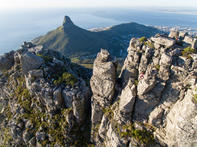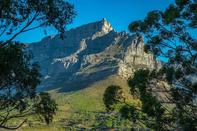The Legend of Adamastor
An ancient story tells of a family of giants who rose up and tried to overthrow the Gods. This titanic revolt was eventually put down, and the angry Gods punished the rebellious giants by banishing them to Earth and turning them into stone. Adamastor, one of these giants, was thus sent to the Southern Oceans and transformed into the rocks and mountains of the Cape Peninsula.

Adamastor then re-appears in the literary record in 1572, when the Portuguese poet Luis de Camoes wrote his epic ‘The Luciads’. In this story, Camoes recounts the epic voyages of European Discovery and, when telling of Da Gama’s expedition around the Cape, he creates a memorable cameo for the menacing Adamastor.
According to Camoes, as Da Gama’s ship neared the tip of the Cape, a dark cloud materialised, taking the shape of an enormous human figure. It was Adamastor, guardian spirit of the Cape of Storms, and he had a menacing message for the explorers. “Beware”, he intoned, “disaster will befall anyone who dares round the Cape”. Sadly, his message did not deter Da Gama, and the Cape of Storms was repeatedly violated from that day forward.
The Legend of Umlindi Wemingizimu - The Watcher of the South

There is another, rather strange legend that the local people tell about the Cape Peninsula, and it goes like this: In the beginning, the world was created by Qamata. But Nganyamba, the mighty sea dragon, tried to prevent Qamata from creating dry land. This did not go down well with Djobela, the one-eyed Earth Goddess.
So, to help Qamata complete the job, Djobela created four giants, one to guard each of the compass points against the dragon. After many battles, the giants were eventually defeated but, before they died, they asked Djobela to turn them into mountains, so that they could complete their task. Djobela agreed and one of these giants became Umlindi Wemingizimu – the Watcher of the South, otherwise known as Table Mountain.